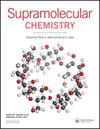基于1,2,3-三唑吡啶-2,6-二羧基酰胺的新型发光镧系配合物的合成、光物理和组装研究
IF 2.6
4区 化学
Q3 CHEMISTRY, MULTIDISCIPLINARY
引用次数: 5
摘要
众所周知的镧系元素结合基序2,6-吡啶二羧基酰胺(2,6-pyridinedicarboxamide)被铜催化叠氮烷偶联(CuAAC)与外围取代基功能化,得到了新的对称“点击”N2, n6 -双((1-(X)- 1h -1,2,3,-三唑-4-基)甲基)吡啶- 2,6-二羧基酰胺(其中X =乙基(1)苄基(2)和2-萘基(3))。这些配体已成功地与三价镧系离子(铕、铽和镧)配位形成[Ln(L)3](CF3SO3)3配合物。这些配体作为Eu3+和Tb3+配合物的有效天线,表现出特有的敏化发射谱。利用UV-Vis,荧光和NMR研究了1-3在溶液中组装成1:3 M:L体系的能力。最后,对基态La3+配合物进行了密度泛函计算,得到了与已有晶体学数据相似的几何和配位参数。这些“点击”pdc基配体的简单和模块化合成使这些化合物成为发光超分子材料开发的优秀候选者。本文章由计算机程序翻译,如有差异,请以英文原文为准。
Synthesis, photophysical and assembly studies of novel luminescent lanthanide(III) complexes of 1,2,3-triazolyl-pyridine-2,6-dicarboxamide-based ligands
ABSTRACT The well-known lanthanide-binding motif, 2,6-pyridinedicarboxamide, has been functionalised with peripheral substituents using copper-catalysed azide alkyne coupling (CuAAC) to develop new symmetrical ‘clicked’ N2,N6-bis((1-(X)-1H-1,2,3,-triazol-4-yl)methyl)pyridine- 2,6-dicarboxamide (where X = ethyl (1) benzyl (2) and 2-naphthyl (3)). These ligands have been successfully coordinated with trivalent lanthanide ions (europium, terbium, and lanthanum) forming [Ln(L)3](CF3SO3)3 complexes. The ligands act as effective antennae for Eu3+ and Tb3+ complexes, which exhibit the characteristic sensitised emission profiles. The ability of 1–3 to assemble into 1:3 M:L systems in solution was investigated using UV-Vis, fluorescence, and NMR. Finally, density functional calculations of the ground state La3+ complexes have been carried out and show similar geometry and coordination parameters to those with available crystallographic data. The facile and modular synthesis of these ‘clicked’ PDC-based ligands makes these compounds excellent candidates for luminescent supramolecular materials development.
求助全文
通过发布文献求助,成功后即可免费获取论文全文。
去求助
来源期刊

Supramolecular Chemistry
化学-化学综合
CiteScore
3.60
自引率
3.00%
发文量
5
审稿时长
2.7 months
期刊介绍:
Supramolecular Chemistry welcomes manuscripts from the fields and sub-disciplines related to supramolecular chemistry and non-covalent interactions. From host-guest chemistry, self-assembly and systems chemistry, through materials chemistry and biochemical systems, we interpret supramolecular chemistry in the broadest possible sense. Interdisciplinary manuscripts are particularly encouraged. Manuscript types include: high priority communications; full papers; reviews, and; Methods papers, techniques tutorials highlighting procedures and technologies that are important to the field. We aim to publish papers in a timely fashion and as soon as a paper has been accepted and typeset it will be published in electronic form on the Latest articles section of the website. The two most important review criteria are that the paper presents high-quality work that fits generally into the broad spectrum of activities in the supramolecular chemistry field. Under normal circumstances, Supramolecular Chemistry does not consider manuscripts that would be more suitable in a highly specialized journal. This includes, but is not limited to, those based mostly or exclusively on topics such as solid state/X-ray structures, computational chemistry, or electrochemistry. .
The two most important review criteria are that the paper presents high-quality work that fits generally into the broad spectrum of activities in the supramolecular chemistry field.
 求助内容:
求助内容: 应助结果提醒方式:
应助结果提醒方式:


